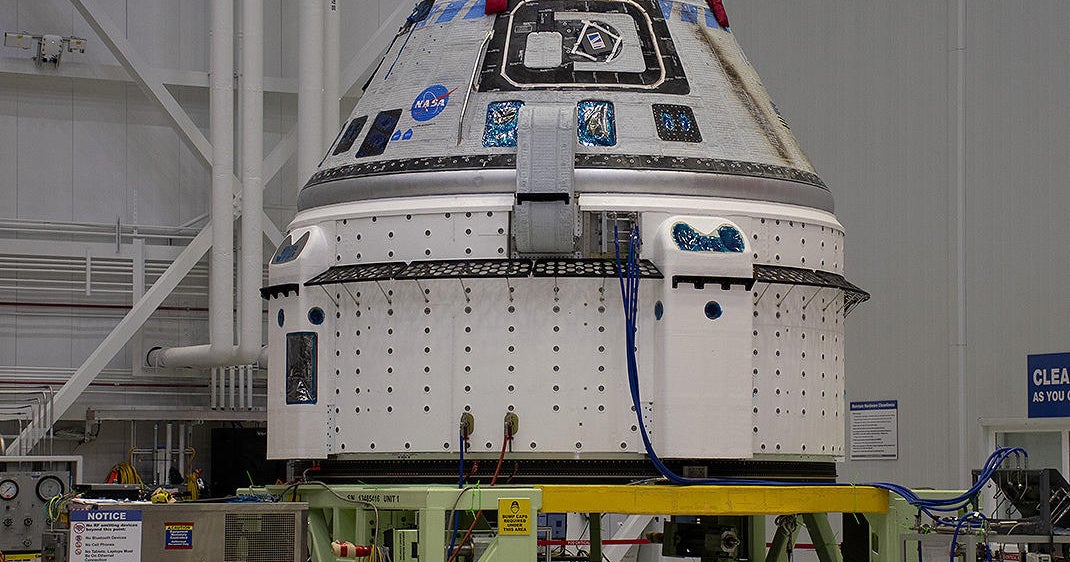The return to Earth of Boeing’s Starliner capsule is on hold indefinitely pending the results of new thrust tests and ongoing analysis of helium leaks that occurred during the ship’s rendezvous with the International Space Station, NASA said Friday.
But agency officials insisted that Starliner commander Barry “Butch” Wilmore and co-pilot Sunita Williams are not “stranded” in space.
NASA
“We don’t have a target (landing) date today,” Steve Stich, NASA’s Commercial Crew Program Manager, told reporters during a conference call. “We’re not going to give a specific date until we complete that test.
“So essentially it’s completing the testing, completing the fault tree, bringing that analysis to (the mission management team), and then an agency-level review. And then we’ll lay out the rest of the plan, from undocking to landing. I think we’re on track.”
The problem for NASA and Boeing is that the Starliner’s service module, which houses the helium lines, thrusters and other critical systems, will be discarded before re-entering and burning up in the atmosphere.
Engineers won’t be able to study the hardware afterwards, so they want to collect as much data as possible before Wilmore and Williams go home.
But the crew’s repeated, extended stays on the space station as analyzes continued have led some observers to suspect that Wilmore and Williams may have been stranded in orbit. This impression seems to have arisen because NASA has not provided any updates as the target landing date kept getting postponed.
Stich and Mark Nappi, Starliner program manager at Boeing, say the description is incorrect.
“It’s pretty painful to read all the stuff that’s coming out,” Nappi said. “We had a really good test flight … and it’s being looked at pretty negatively. We’re not stuck on the ISS. The crew is not in danger and there’s no increased risk if we decide to bring Suni and Butch back to Earth.”
Stich added that he “wants to make it very clear that Butch and Suni are not stranded in space. Our plan is to continue to bring them back on Starliner and bring them home at the right time. We still have some work to do to get there.” to arrive for the final return, but they are safe on the space station. Their spacecraft is working well and they are enjoying their time on the space station.”
The Starliner was launched on June 5 on the program’s first crewed test flight with one known helium leak. The other four were created during the ship’s rendezvous with the space station when the jets were rapidly pulsed to fine-tune the Starliner’s approach.
United Launch Alliance
While docked at the station, the valves are closed to isolate the helium system, eliminating additional leakage. But once Wilmore and Williams leave and go home, the valves are opened again to repressurize the lines or manifolds.
Stich said that even with the known leaks, the spacecraft will have 10 times as much helium as it needs to get home, but engineers want to make sure the leaks don’t get worse once the system is repressurized.
The five rear-facing thrusters in the Starliner’s service module also did not function as expected during the station’s approach on June 6.
After docking, four of the five jets were successfully tested and despite slightly lower power levels than expected, they are considered good to be undocked and re-entered. The fifth thruster was not “hot fired” as previous performance indicated that it had indeed failed.
But managers want to find out what caused the other four’s unexpected behavior. Starting next week, a new thruster identical to the one aboard the Starliner will be tested at a government facility in White Sands, New Mexico, just as the thrusters were fired into space during the rendezvous and docking of the Starliner.
“We will recreate that profile,” Stich said. “Then we will put quite an aggressive profile in the thruster for the (disengage to re-enter) phase.”
NASA
It is possible that the problems with the rear-facing thrusters were caused by higher-than-normal temperatures due to the Starliner’s orientation relative to the sun, or the series of rapid, repetitive firings commanded by the flight software. Or both.
The soil tests, which are expected to last “a few weeks,” could provide evidence one way or another.
“This is a real opportunity to examine a thruster like we’ve had in space on the ground, a detailed inspection,” Stich said. “Once that test is done, we’ll look at the landing plan.”
As for the impression that the crew is stranded in space, Stich and Nappi both pointed out that a defunct Russian satellite in a slightly lower, more tilted orbit than the space station suffered a catastrophic “event” that killed more than 100 of its of the space probe. traceable debris.
While flight controllers assessed the orbit of the wreckage, the nine-person crew of the space station was instructed to “stay inside” their own spacecraft, ready to depart immediately and return to Earth in the event of a damaging impact.
Two Russian cosmonauts and NASA’s Tracy Dyson boarded their Soyuz ferry, while three NASA astronauts and another cosmonaut floated in their SpaceX Crew Dragon. Wilmore and Williams rode to a safe haven in the Starliner and were cleared to fly home if warranted.
After about an hour, the crew was given the signal to return to normal work. If the Starliner had been deemed unsafe, Wilmore and Williams would likely have been told to take refuge in the Crew Dragon. But that wasn’t the case.
“We have permission to act as a lifeboat in case of an emergency on the ISS,” Nappi said. “That means we can return with the Starliner at any time, and that’s what we’ve proven this week.”
